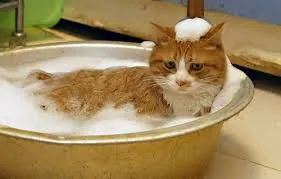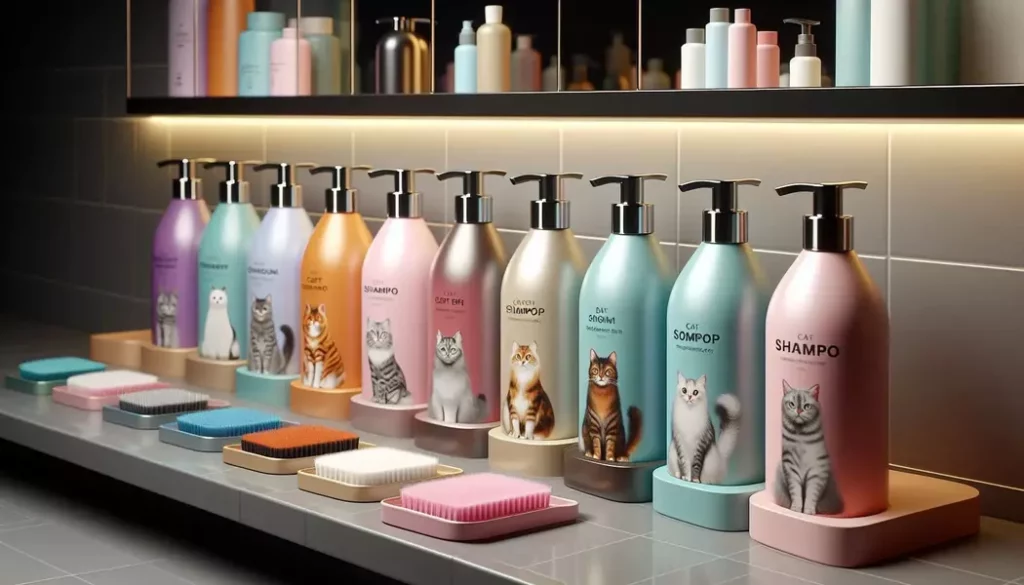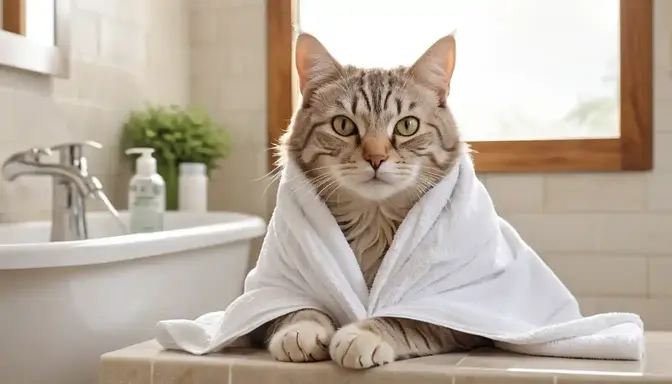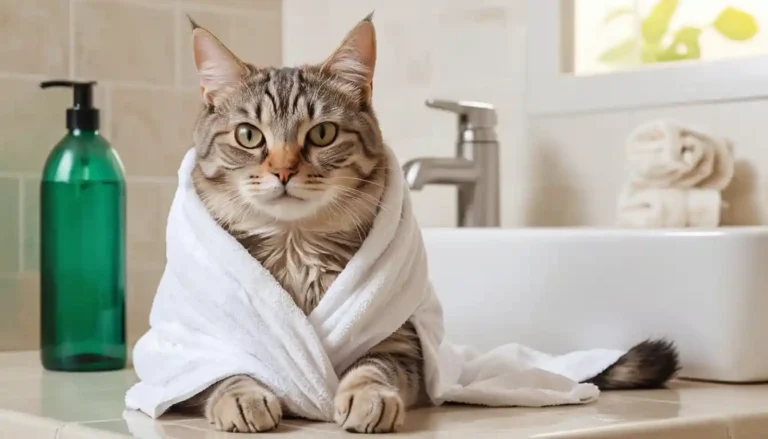Choosing the right cat shampoo prevents skin damage and keeps your feline healthy. Unlike humans, cats need pH-balanced formulas specifically designed for their delicate skin.
In this comprehensive guide, we’ll help you select the perfect cat shampoo based on your feline’s unique needs, skin type, and health conditions – with insights straight from veterinary dermatologists.
Why Your Cat’s Skin Needs Specialized Care
Your cat’s skin is far more delicate than yours, requiring specially formulated products to maintain its protective barrier.
Using the wrong shampoo can strip natural oils, cause irritation, and even lead to infections.
Understanding these biological differences is the first step to keeping your cat healthy and comfortable.
The Critical pH Balance Difference
A cat’s skin maintains a pH between 6.2 and 6.6, which differs significantly from human skin (around 5.5) and even dog skin (6.8-7.5).
This seemingly small difference is crucial because when the pH is disrupted, your cat’s skin barrier becomes compromised.
Human shampoos are too acidic for cats, while most dog shampoos are too alkaline, both potentially causing dryness, itching, and sensitivity.
Always verify that any product labeled for “cats and dogs” actually specifies feline safety, as many are primarily formulated for dogs.
How Human Products Damage Feline Skin
Never use shampoo or conditioner designed for people on your cat, as they contain different pH levels that could damage your pet’s skin.
Human products often contain sulfates, parabens, and artificial fragrances that strip away natural oils essential for feline skin health.
When the skin barrier is disrupted, cats become vulnerable to environmental allergens, bacteria, and yeast overgrowth.
The pH imbalance from human products can cause immediate irritation and long-term skin conditions that require veterinary treatment.
Even “gentle” baby shampoos aren’t suitable because they’re still formulated for human pH levels.

Top 5 Dangerous Ingredients to Avoid in Cat Shampoo
Selecting a safe cat shampoo requires careful label reading. Many products marketed for pets contain ingredients that pose serious risks to cats.
Essential Oils (Most Varieties)
Most essential oils are not safe for cats and can quickly cause toxicity, as they are rapidly absorbed both by mouth and through the skin, where they accumulate in the liver.
Cats lack the necessary liver enzymes to break down these compounds safely. Particularly dangerous oils include wintergreen, sweet birch, citrus oil (d-limonene), pine oils, and Ylang Ylang oil.
While some brands market “natural” shampoos with essential oils, remember that “natural” doesn’t always mean safe for cats.
If a product lists essential oils as ingredients, check that they’re specifically formulated for felines and contain no more than 1% concentration.
Phenols and Cresols
Phenols are commonly found in antibacterial and disinfectant products, but are extremely toxic to cats.
These chemicals can cause severe liver damage and neurological problems. Many all-purpose cleaners and some medicated shampoos contain phenol derivatives.
Cats are particularly vulnerable because they groom themselves constantly, ingesting any residue left on their fur.
Always avoid shampoos containing “phenol,” “cresol,” or “hexachlorophene” on the ingredient list.
Pyrethrins and Pyrethroids (In High Concentrations)
While some flea shampoos contain pyrethrins (derived from chrysanthemums), these can be dangerous if improperly formulated.
Cats are especially sensitive to pyrethroids (synthetic versions), which can cause tremors, seizures, and even death at high concentrations.
Only use flea shampoos specifically labeled for cats and follow dosage instructions precisely.
Never use dog flea products on cats, as they often contain higher concentrations of these chemicals that are fatal to felines.
Artificial Fragrances and Dyes
Synthetic fragrances and dyes serve no purpose other than marketing appeal but can trigger allergic reactions in sensitive cats.
These chemicals often appear as “parfum,” “fragrance,” or color additives like “FD&C Red No. 40.”
Cats have extremely sensitive respiratory systems, and artificial scents can cause breathing difficulties, especially in breeds like Persians with flat faces.
Fragrance-free formulas are always safest for cats with any history of skin or respiratory issues.
Harsh Sulfates and Parabens
Sodium lauryl sulfate (SLS) and sodium laureth sulfate (SLES) create rich lather but strip natural oils from your cat’s skin.
Parabens, used as preservatives, have been linked to hormone disruption in mammals. These ingredients can cause immediate dryness and long-term skin barrier damage.
Look for gentler alternatives like cocamidopropyl betaine (derived from coconut oil) as the primary cleansing agent.
For preservation, natural options like vitamin E or rosemary extract are safer choices for your cat’s sensitive system.
Matching Cat Shampoo to Your Feline’s Specific Needs
Not all cats require the same shampoo formula. Your selection should align with your cat’s age, coat type, skin condition, and any medical concerns.
Understanding these variables ensures you choose a product that addresses specific challenges while supporting overall skin health. Let’s explore which formulas work best for different feline needs.
For Sensitive or Allergic Skin
Cats with sensitive skin need hypoallergenic formulas free from common irritants. Burt’s Bees for Cats Hypoallergenic Shampoo is a top vet pick for everyday gentle use on mildly sensitive skin, featuring soothing shea butter and honey.
For more severe sensitivities, Veterinary Formula Clinical Care Hypoallergenic Shampoo provides a vet-approved option designed specifically to be gentle on reactive skin.
Look for products containing colloidal oatmeal at therapeutic concentrations (around 1%), which calms inflammation and repairs the skin barrier.
Avoid any shampoo with artificial fragrances, dyes, or harsh sulfates that could trigger reactions. For cats with diagnosed allergies, consult your vet about medicated shampoos containing chlorhexidine or ketoconazole.
For Flea & Tick Prevention
When choosing flea shampoo, prioritize safety alongside effectiveness. Adams Plus Flea & Tick Foaming Shampoo is a good option for cats with sensitive skin, designed to kill fleas and ticks without excessive harshness.
However, most vets recommend that flea shampoos be a last resort for infestations rather than regular prevention, as they can dry out skin with frequent use.
For ongoing protection, consider spot-on treatments or oral medications prescribed by your veterinarian instead of relying solely on shampoo.
If using flea shampoo, follow with a gentle moisturizing conditioner to counteract drying effects, and never use dog flea products on cats—they contain ingredients toxic to felines.
For Longhaired Breeds
Persians, Maine Coons, and other long-haired cats need shampoos that prevent matting while adding slip to the coat.
Earthbath Oatmeal & Aloe Shampoo works well for these breeds, providing gentle cleansing while detangling fur.
Look for formulas containing natural conditioners like aloe vera, shea butter, or coconut oil that help maintain coat manageability.
Avoid heavy oils that might weigh down the fur or attract dirt. For severely matted coats, consult a professional groomer rather than attempting to shampoo at home, as improper handling can cause skin damage.
Always follow shampooing with thorough brushing using appropriate tools for long fur.
For Senior Cats
Older cats often develop thinner skin and reduced natural oil production, requiring extra-moisturizing formulas.
DermAllay Oatmeal Shampoo is excellent for seasonal allergies and dry skin common in senior felines. Choose shampoos with ceramides and fatty acids that replenish the skin barrier without overwhelming their sensitive systems.
Avoid any products with strong scents or medicated ingredients unless specifically recommended by your vet. For arthritic seniors, consider waterless foam shampoos that minimize handling stress.
Always ensure thorough rinsing to prevent residue that could irritate their more delicate skin.
How to Choose the Perfect Cat Shampoo
Selecting cat shampoo requires more than grabbing the nearest bottle. Follow this vet-approved process to match products to your cat’s unique needs. Skipping steps risks skin damage or wasted money on ineffective formulas.
Assess Your Cat’s Current Condition
Before shopping, evaluate:
- Skin: Check for redness, flaking, or sores (indicates need for medicated shampoo)
- Coat: Shine level and matting (dull coat = oil-stripping product history)
- Behavior: Excessive licking suggests irritation requiring soothing formulas
Pro tip: Take photos of problem areas to show your vet—this determines if you need prescription shampoo.
Vet Consultation Essentials
Never skip professional advice for:
- First-time shampoo use (kittens under 6 months)
- Pre-existing conditions (kidney disease, diabetes)
- Persistent scratching after 2 baths
Ask your vet: “Which active ingredients are safe with my cat’s current medications?” Some shampoos interact dangerously with flea preventatives.

Vet-Approved Top 7 Cat Shampoos
With countless options on the market, selecting the right cat shampoo can feel overwhelming. We’ve consulted veterinary dermatologists and analyzed hundreds of products to bring you the top 7 scientifically backed choices for various feline needs.
Each recommendation prioritizes safety, effectiveness, and feline-specific formulation.
Comparison of Top-Rated Cat Shampoos
| Product Name | Best For | Key Ingredients | pH Level | Special Features |
|---|---|---|---|---|
| Hepper Colloidal Oatmeal Pet Shampoo | Overall best | Colloidal oatmeal, aloe vera | 6.5 | Soothes irritation, fragrance-free |
| Burt’s Bees Hypoallergenic Shampoo | Sensitive skin | Shea butter, honey | 6.4 | Hypoallergenic, gentle cleansing |
| Earthbath Oatmeal & Aloe Shampoo | General use | Oatmeal, aloe, coconut | 6.4 | Natural cleanser, detangles |
| Veterinary Formula Clinical Care | Medicated needs | Chlorhexidine, miconazole | 6.5 | Treats infections, vet-recommended |
| Adams Plus Flea & Tick Foaming Shampoo | Flea control | Pyrethrins, piperonyl butoxide | 6.8 | Kills fleas, gentle formula |
| Douxo S3 Calm Shampoo | Allergies | Ophytrium, ceramides | 6.3 | Repairs skin barrier, anti-itch |
| Dermoscent Atop 7 Shampoo | Inflammation | Essential fatty acids | 6.4 | Reduces itching, vet-grade |
Detailed Product Analysis
Hepper Colloidal Oatmeal Pet Shampoo earns the #1 spot as the best overall cat shampoo for 2024.
Its therapeutic concentration of colloidal oatmeal soothes irritation while maintaining the skin’s natural pH balance.
Free from artificial fragrances and harsh chemicals, it’s suitable for cats with the most sensitive skin.
The formula rinses cleanly without residue and leaves coats soft and manageable.
Most importantly, it’s developed with veterinary input specifically for feline physiology.
Burt’s Bees for Cats Hypoallergenic Shampoo stands out for everyday gentle cleansing. Formulated with shea butter and honey, it nourishes while cleaning without stripping natural oils. The pH level (approximately 6.4) aligns perfectly with feline skin requirements.
This shampoo works particularly well for cats with mild sensitivities or those who need regular bathing due to medical conditions. The natural ingredients minimize reaction risks while effectively removing dirt and dander.
Earthbath Oatmeal & Aloe Shampoo offers excellent value for general cat care. Its balanced formula cleans without over-drying, making it suitable for most cats needing routine bathing.
The oatmeal soothes minor irritations while aloe vera provides hydration. Though labeled for both cats and dogs, it maintains an appropriate pH for felines.
This product is ideal for households with multiple pets or for cats without specific skin concerns who simply need occasional cleaning.
Veterinary Formula Clinical Care Hypoallergenic Shampoo is the top medicated recommendation from veterinary dermatologists. Developed specifically for cats with reactive skin, it contains no dyes, parabens, or artificial fragrances.
The formula supports the skin barrier while gently cleansing, making it suitable for cats with diagnosed allergies or chronic skin conditions. Many vets recommend this as part of a comprehensive treatment plan for feline dermatitis.
Adams Plus Flea & Tick Foaming Shampoo provides effective parasite control without excessive harshness. The foaming formula makes application easier and more thorough than traditional shampoos.
While flea shampoos shouldn’t be used frequently, this option is gentler than many alternatives when immediate flea elimination is necessary. Always follow with a moisturizing conditioner to counteract any drying effects.
Douxo S3 Calm Shampoo excels for cats with chronic skin inflammation. Its patented Ophytrium technology reduces itching while ceramides repair the skin barrier.
Developed with veterinary input, this shampoo addresses the root causes of irritation rather than just symptoms. It’s particularly effective for cats with seasonal allergies or environmental sensitivities that cause persistent scratching.
Dermoscent Atop 7 Shampoo is a veterinary-grade product designed to alleviate skin inflammation and itchiness. Containing essential fatty acids, it nourishes the skin while cleansing.
This shampoo works well as part of a long-term management plan for cats with chronic dermatitis. While pricier than retail options, its clinical effectiveness makes it worth considering for cats with persistent skin issues.

Step-by-Step: How to Safely Bathe Your Cat
Bathing a cat requires patience and proper technique to minimize stress for both you and your feline.
Most cats naturally stay clean through grooming, but sometimes bathing becomes necessary due to medical conditions, severe soiling, or specific skin treatments.
When done correctly, bathing can be a safe, even positive experience that supports your cat’s health.
Pre-Bath Preparation Checklist
Gather all supplies before bringing your cat to the bathing area: cat-specific shampoo, two soft towels, a non-slip mat, and a handheld sprayer if available.
Trim your cat’s nails 24 hours beforehand to prevent scratches during the process. Brush your cat thoroughly to remove loose hair and prevent matting when wet.
Choose a small, enclosed space like a sink or small tub rather than a large bathroom where your cat might feel exposed.
Most importantly, ensure the room is warm (75-80°F) to prevent chilling, as cats lose body heat quickly when wet.
The 5-Step Bathing Process
- Create a Calm Environment: Speak softly and move slowly to avoid triggering fear. Place a non-slip mat in the sink or tub and fill with 2-3 inches of lukewarm water (test with your elbow—it should feel barely warm).
- Gentle Wetting: Use a cup or handheld sprayer on the lowest setting to moisten fur, avoiding the face, ears, and eyes completely. Start at the neck and work backward, never pouring water directly onto your cat.
- Proper Shampoo Application: Dilute shampoo with equal parts water in your hand before applying. Massage gently in the direction of hair growth, focusing on the dirtiest areas first. Never rub vigorously—use light circular motions with fingertips.
- Thorough Rinsing: Rinse 2-3 times longer than you shampooed, ensuring no residue remains. Leftover shampoo is a common cause of post-bath itching. Check by running a damp cloth over the coat—it should come away clean.
- Stress-Free Drying: Wrap your cat in a soft towel immediately, applying gentle pressure without rubbing. Never use hair dryers, as the noise and heat terrify most cats. Allow your cat to finish drying in a warm, quiet space with hiding options available.
Pro Tips for Stress Reduction
Place a familiar-smelling item like your t-shirt in the bathing area to provide comfort. Consider using Feliway diffusers 30 minutes before bathing to reduce anxiety.
If your cat shows extreme distress, stop immediately—forced bathing creates negative associations that make future necessary baths impossible.
For cats who absolutely refuse water, try waterless foam shampoos applied with a damp cloth. Always reward with high-value treats after the process, even if it wasn’t perfect.
Remember that most cats only need bathing when medically necessary—over-bathing strips natural oils and causes more harm than good.
FAQs
Can I use baby shampoo on my cat in an emergency?
No—baby shampoo still has the wrong pH balance for cats (around 5.5-6.5) compared to feline skin’s 6.2-6.6 range. While less harsh than adult shampoos, it can still disrupt your cat’s skin barrier. In true emergencies, a damp cloth with plain water is safer than using human products. Always consult your vet before using any non-feline-specific product.
How often should I bathe my cat with shampoo?
Most cats need shampoo bathing only 1-2 times per year unless medically necessary. Over-bathing strips natural oils and damages the skin barrier. Cats with medical conditions may require more frequent medicated baths as directed by a veterinarian. Between shampoo baths, use waterless foam cleansers for spot cleaning as needed.
What are the signs my cat is reacting to shampoo?
Watch for excessive scratching, redness, hair loss, or skin flakiness within 24 hours of bathing. Some cats develop hives or facial swelling with severe reactions. If you notice these symptoms, rinse thoroughly with water and contact your vet immediately. Discontinue use of the product and bring the shampoo bottle to your appointment.
Are natural/organic cat shampoos always safer?
Not necessarily—many “natural” products contain essential oils toxic to cats. Organic doesn’t guarantee safety for felines. Always verify ingredients against known toxic substances and ensure pH balance is appropriate. The safest products are those specifically formulated and tested for cats, regardless of marketing claims.
Can I use dog flea shampoo on my cat?
Absolutely not—dog flea products often contain permethrin or higher pyrethrin concentrations fatal to cats. Even small amounts transferred from a dog to a cat can cause severe neurological symptoms. Always use products labeled specifically for cats, and never assume “pet” means suitable for all species.
Conclusion
Choosing the right cat shampoo requires understanding your feline’s unique skin biology and specific needs. Remember that a cat’s skin pH (6.2-6.6) differs significantly from humans (5.5) and dogs (6.8-7.5), making species-specific formulas essential.
Avoid dangerous ingredients like most essential oils, phenols, and high-concentration pyrethrins that can cause serious harm. For most cats, bathing should be rare—focus instead on regular brushing and spot cleaning.
When shampooing is necessary, select vet-recommended products matching your cat’s condition, like colloidal oatmeal formulas for sensitive skin or medicated options for specific issues.
Always prioritize safety over convenience, and consult your veterinarian before introducing new products, especially for cats with existing skin conditions.
Your cat’s skin health starts with informed choices—make every bath count by using only products designed for their delicate physiology.






